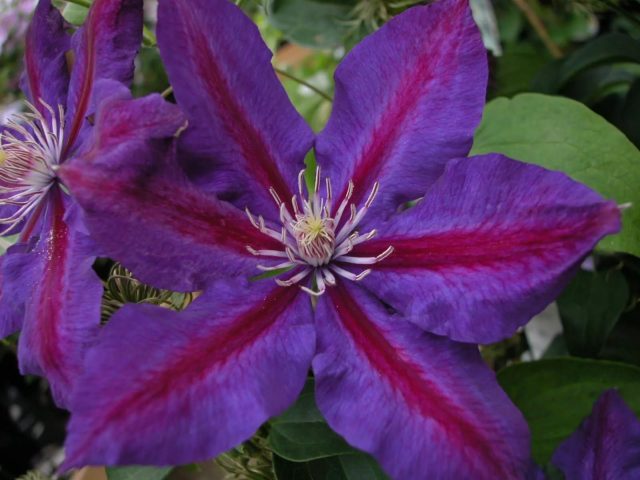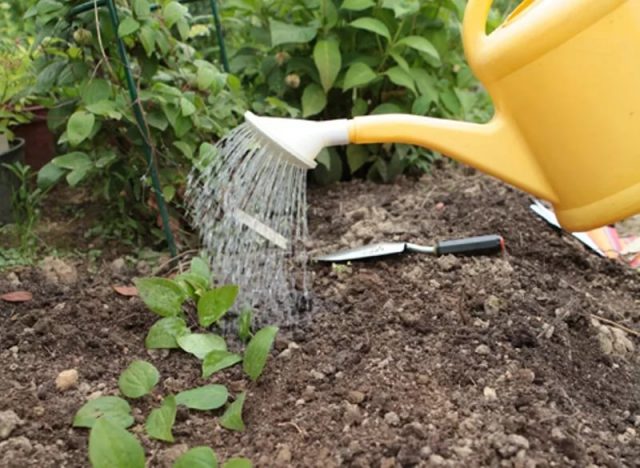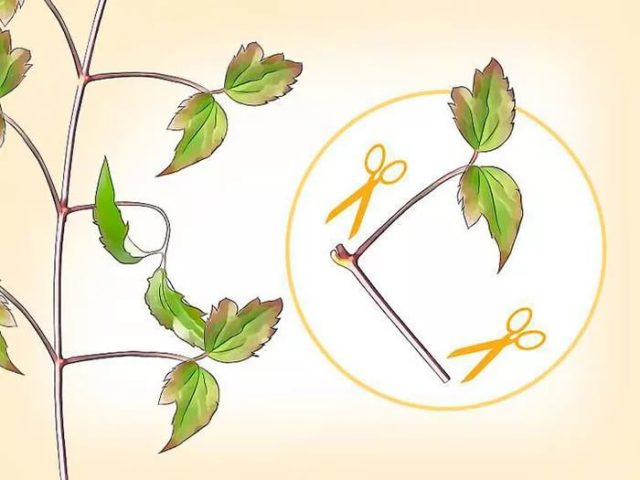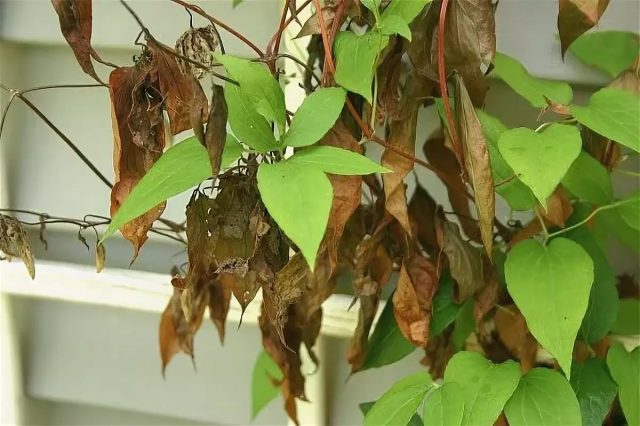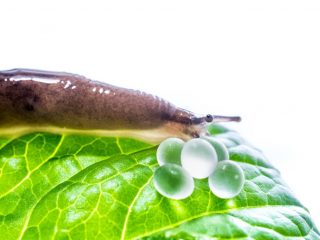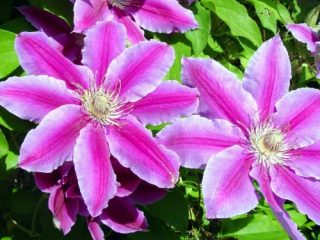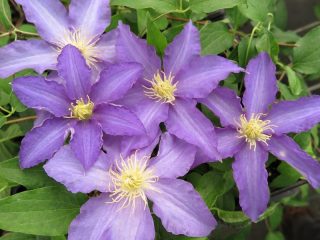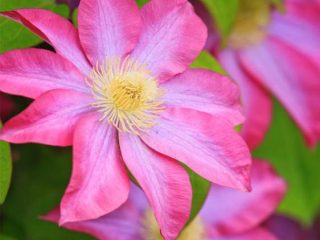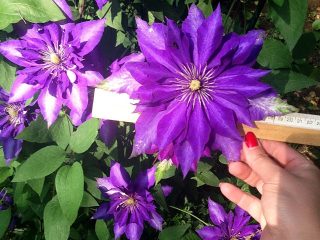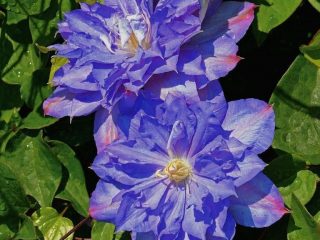Content
Large-flowered clematis are a real decoration of the garden. Such flowers can bring real aesthetic pleasure to visitors, and become real pride for the gardener. One of these species is Clematis Wildfire, whose impressive size is harmoniously combined with its beauty and grace.
Description of clematis Wildfire
Clematis grandiflora Wildfire, a description and photo of which are given below, was bred by Polish breeders. Widely used for decorative purposes, for vertical gardening, decorating gazebos, they are often planted along fences, walls of buildings, and nets. The photo below shows a blooming clematis variety Wildfire.
The main characteristics of the plant are shown in the table below:
Parameter | Meaning |
Type | Perennial herbaceous plant of the Ranunculaceae family |
Stem | Curly, 2-3 m |
Leaves | Green, trifoliate. Thanks to the petioles, the plant is supported |
Flowers | Large, up to 20 cm, with 6-8 violet-blue petals, in the middle of which there is a longitudinal burgundy or purple blurred stripe |
Flowering time | May-September |
Reproduction | By seeds, cuttings, shoots, dividing the bush |
Planting and caring for clematis Wildfire
Clematis Wildfire can be planted in open ground both in spring and autumn.In both cases, this must be done before the onset of unfavorable conditions - summer heat or frost, which can destroy fragile plants. The best time is considered to be the period from late April to mid-May, as well as September. It is better to prepare the planting holes in advance and make them large enough. Their depth should be 50-60 cm, since it is advisable to pour a 10-15 cm thick drainage layer of broken brick, expanded clay or crushed stone onto the bottom. Clematis Wildfire is planted with the root collar deepened by 5-10 cm. If there are no buildings or fences near the planting site, the plant is tied to a support. The root zone is shed generously with water and mulched with peat to retain moisture in the soil.
Aftercare for Wildfire clematis is simple. Until 3 years of age, watering is carried out quite often, then the intensity is reduced. From this same time, intensive growth of new shoots begins, which can be regulated by pruning or pinching growth points.
You can use special formulations for this, such as Kemira-universal or complex mineral fertilizers, which must be applied in dissolved form. The plant also responds well to fertilizing with slurry solution.
Reproduction
To preserve all the varietal characteristics of the plant, clematis Wildfire should be propagated not by seeds, but by any vegetative method:
- cuttings;
- layering;
- dividing the bush.
Cuttings are the easiest way to propagate clematis Wildfire. You can do this from May to September. Cuttings are cut from vines of plants no younger than 2 and no older than 5 years.It is best to use a sharp utility knife and a regular cutting board for this. The cut is made in such a way that 1-2 cm remains above the internode, and 5-6 cm below. Cuttings can be rooted immediately using containers filled with nutrient soil. You can prepare it yourself by mixing sand and peat in equal proportions. To reduce moisture evaporation, the leaf blade is trimmed.
You can root clematis Wildfire in water. In this case, a bunch of cuttings is placed in a glass of water. In about 1.5-2 months they will produce their own roots. After their length reaches 3-4 cm, the cuttings can be planted in the ground. Further exposure to water will lead to their death.
Propagating clematis Wildfire by layering from the mother bush is also quite simple. To do this, in the spring, dig in a young flexible shoot. After some time, the internodes will begin to take root, and a young shoot will develop from each. For the winter, the cuttings are left together with the mother plant, and in the spring they are cut off and planted in a permanent place.
The method of propagating clematis Wildfire by dividing the bush is also a way of rejuvenating it. Over time, the volume of the plant's roots increases many times over, which leads to the fact that the bush begins to lack nutrients. In this case, it is more expedient to divide the bush into several parts, each of which will subsequently become an independent plant. Plants under 7 years of age can be divided.
This procedure can be carried out in autumn or spring. The shoots are cut out almost to the base, leaving only a few renewal buds on the stumps.After this, the bush is dug out of the ground and divided with a sharp knife into several parts, divisions, each of which should contain both the root system and renewal buds. The resulting divisions are planted in prepared holes, covered and spilled generously with water.
Video about planting clematis Wildfire:
Diseases and pests
Clematis Wildfire can be affected by both viral and fungal diseases. The most common diseases of this plant are the following:
- Withering. Caused by a soil fungus that attacks the roots. The disease can occur due to excessive soil moisture or lack of sunlight. Affected plants must be destroyed. Prevention is the treatment of plantings in the spring with an aqueous solution of copper sulfate 1%.
- Gray rot. A fungal disease that appears in cold, damp weather as a gray coating on the leaves. Affected plants are destroyed, and the plantings are treated with a foundation solution.
- spotting (ascochyta blight) of leaves. It appears as brown spots on the leaves, which then dry out and become colored, forming holes. The affected leaves need to be torn off and the plants treated with a solution of copper sulfate.
- Powdery mildew. It often appears in hot weather as a white coating on leaves and flowers. The affected parts of the plant need to be torn off and destroyed, and then the bushes should be treated with a solution of copper sulfate or soda ash.
- Rust. This fungal disease can be detected by the appearance of spore pads appearing on the leaves. When rust appears, the infected parts of the plant are torn off, and then the plantings are treated with Bordeaux mixture.
Of the insect pests, the following can cause the most problems for clematis Wildfire:
- Nematodes. Insects that live in the ground and feed on plant roots. It is very difficult to get rid of nematodes, so it is more advisable to refuse to grow Wildfire clematis in this place. As a biological protection, you can plant calendula, marigolds or garlic nearby.
- Spider mite. It is detected by a thin web entangling the leaves. It feeds on the sap of the plant, inhibiting it. When spider mites appear, plants are treated with garlic infusion or Actellik.
- Aphid. Sucks juices from the plant. If aphid colonies are detected, plants must be treated with insecticides.
To prevent the appearance of pests and diseases, it is necessary to carry out preventive treatments of plants in a timely manner, as well as loosen and weed the soil, and prevent the plantings from becoming very dense.
Conclusion
It is not for nothing that Clematis Wildfire received such a name, which means “wild fire” in English. The flowers of this plant really resemble flames of an unnatural violet-red color. They look great either just on a green background or in combination with flowers of a different color. Wildfire clematis are unpretentious in care, so even novice gardeners can grow them.
